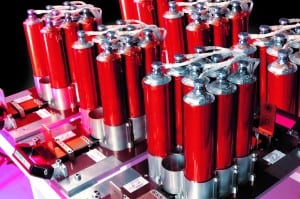Latest News
[Via Satellite 03-31-2014] Battery technology company Saft is looking to discoveries across multiple industries in order to improve the relatively slow pace of development for space-specific batteries. For satellites, batteries take seven to 10 years of testing before ever being used. This lengthy test time can stifle creativity, which is why Saft has developed a dual focus on preventing obsolescence and spurring on new improvement by pooling research and development discoveries from various initiatives.
“In space, the design changes are executed over many years with a big generation change; whereas the consumer world practically changes 10 times a day,” explained Annie Sennet, general manager of Saft’s space and defense division. “Terrestrial batteries for tanks or even missiles change every one or two years. In space it has to be a bigger increment, so we have to stay with older materials for a longer period of time.”
Saft invests a significant amount of the company’s resources on research and development. According to Sennet, demands from agencies like the Defense Advanced Research Projects Agency (DARPA) and military research labs provide a lot of the new goals. Part of Saft’s research, however, is targeted toward trends that are apparent in the satellite industry today, including smaller satellites and longer lifespans.
“Customers want lighter power solutions, and Lithium-ion is about less than half the weight of the old Nickel-Hydrogen technology,” said Sennet. “There is nowhere else on the satellite that you can remove that much mass by altering one technology.”
According to Sennet, keeping an eye on satellite evolution is a must for a company whose products require years of development and testing. Saft has designed its batteries to last for satellite lifespans of 18 years, should they grow beyond the typical 15 years for geosynchronous satellites. As satellites get smaller, Saft is working on designing new technology to match the needs of a growing section of the satellite market.
“To be efficient, to meet requirements and to be cost effective, we produce a certain cell size that is adequate for [GEO] applications,” said Kamen Nechev, CTO at Saft. “However when we go to small satellites, we can’t address those needs with the same standard space cells … we have a couple of products now for space that are in a much smaller cell format. These are specifically targeting some of these LEO or micro-sats that cannot use a large standard space cell that Saft manufactures.”
More than 70 percent of Saft’s research and development investment is in Lithium-ion batteries, which, at their core, are not far removed from the batteries that power cell phones. Lithium-ion is 98 to 100 percent efficient in terms of charge, eliminating the need to build in extra power. This was previously done by oversizing solar arrays to compensate for the weaknesses of Nickel-Hydrogen, which are now mostly phased out. Because space-batteries are a small application — compared to the millions in consumer devices — programs from space agencies as well as military branches provide much of the direction. Saft has found ways to conflate the needs of multiple programs to speed up the pace of satellite battery technology.
“What happens often is the defense community has needs that are very aggressive and special … all of these performance parameters, when we achieve them under a defense program, they actually play very nicely in space,” explained Nechev. “For instance, developing a battery that has very high charge acceptance for a military vehicle has immediate applicability to improving cycle life for a space product. A battery developed for the Navy with increased specific energy, again immediately has an impact on improving specific energy on a space product.”
Batteries for cars and tanks are made on the same equipment as those used in space. A unique case of overlap comes from Saft’s directed energy studies. Batteries used in launches for stage separations need to provide very high power for a brief period of time. Since they do not need to cycle very much, they can be used to power lasers for disconnecting rocket sections. As always, these batteries require a significant amount of testing, but have been found useful for new applications.
“We have never had a failure in orbit,” said Sennet. “That is paramount for us … right now we are modernizing our design to use more current electrochemical materials, and to offer more current industrial practices so that the batteries can be made in a more efficient way.”
Get the latest Via Satellite news!
Subscribe Now